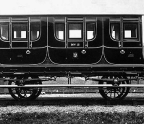
Two Palaces
To begin this story we need to step back in time to Hyde Park in London on 1st May 1851. There Queen Victoria and Prince Albert inaugurated the great exhibition of international achievements, within a giant and innovative building, a symbol for the age. When the outstandingly successful exhibition ended the Palace was dismantled and its components used to create a similar building on Sydenham Hill in South London. This ‘Crystal Palace’ was to be a centre for displays, musical recitals, circuses and other such events.
Not to be outdone by developments south of the Thames there were soon calls for a similar venue in North London and entrepreneurs bought Tottenham Wood Farm, a largely undeveloped area high above Wood Green. This was to become the 240-acre ‘Alexandra Park’, named after the Princess of Wales. The promoters also acquired the cast iron structures of the 1862 International Exhibition, held in South Kensington on land bought from the profits of the 1851 Exhibition, now housing the Natural History and Science Museums. The material was transported north, to be the basis of an ‘Alexandra Palace’. Both new palaces were remote from populations and required new train services to handle the large numbers of visitors which were confidently expected. The Crystal Palace was to be served by two railways, the LBSCR in 1854, and the LCDR in 1865 (closed 1954). There was, of course, already a railway on the eastern side of Alexandra Park, the Great Northern Railway (GNR) main line and Wood Green station was opened at the foot of the hill in 1868 (many years later to be renamed, somewhat misleadingly, ‘Alexandra Palace’). A second railway route to the Palace was opened by the Great Eastern in 1878, its terminus, still further from the Park, named with some impudence ‘Palace Gates’. In this article we shall be looking at a third route, the GNR's Alexandra Palace branch, although the story is interwoven with the neighbouring GNR lines.

To the Northern Heights
In modern times we think of the ex-GNR suburban services as two routes, along the main line (then four-tracked as far as New Barnet) and on the former Enfield line, later the Hertford loop. But this is to overlook the busy line which once diverged westwards at Finsbury Park, towards Edgware and High Barnet. Climbing steeply away, the railway ascended what were rightly termed ‘The Northern Heights’, their highest point about 310 feet. The route originated as the Edgware, Highgate and London Railway




